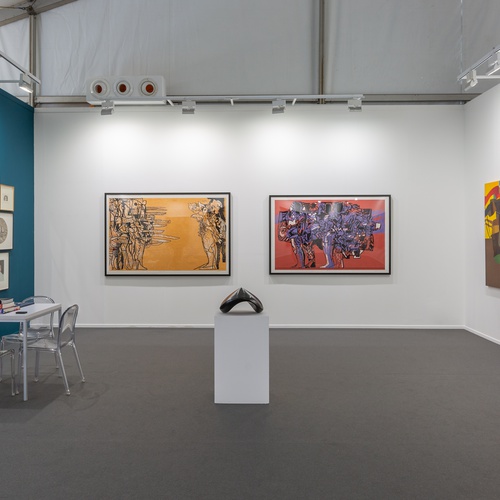Meem Gallery is pleased to announce its participation in this year's Art Dubai, featuring works by Armen Agop, Dia al-Azzawi, Huguette Caland and Marwan.
ABOUT THE ARTISTS
Armen Agop
Armen Agop is an Egyptian artist based in Pietrasanta, Italy. Born in Cairo in 1969 to Armenian parents, Agop graduated from the Faculty of Fine Arts at Helwan University, Cairo in 1992 and went on to receive a research scholarship at the same institution. In 1998, the artist won the Sculpture prize at the Autumn Salon in Cairo, and in 2000 he was awarded the prestigious State Award for Artistic Creativity (Rome Prize).
After moving to Italy, Agop was awarded the Sculpture Grant by the Swedish organisation KKV-B in 2008. In 2010, he was invited to participate in the Biennale Internazionale di Scultura Della Regione Piemonte, where he won the international Umberto Mastroianni Award. The artist was awarded the Premio Sulmona, Rassegna Internazionale D’Arte Contemporanea in 2013.
Armen Agop’s works are represented in the collections of the Egyptian Modern Art Museum, Egypt; Aswan Open Air Museum, Egypt; Mathaf Arab Museum of Modern Art, Qatar; Boghossian Foundation, Belgium; Giardino di Piazza Stazione, Italy and Coral Springs Museum of Art, USA.
Dia al-Azzawi
Over more than half a century, Dia al-Azzawi’s work has been shown in countless group and solo exhibitions worldwide, especially in Europe and across the Arab World (including three retrospectives: Paris, 2001; Abu Dhabi, 2009; Doha, 2016–17). As well as a large collection of limited-edition prints, his work has featured in myriad publications and can be found in numerous public and private collections. Best known as a colourist painter, Azzawi celebrates Arab culture in his work, while blurring the boundaries between artforms and embracing ever new technologies. His works can be distinguished by their impressive scale (especially monumental paintings, sculptures and architectural design) and the amalgamation of images and the written word (works on paper and artist’s books).
Huguette Caland
The daughter of Bechara El Khoury, the first post-independence president of Lebanon, Huguette Caland spent her early life in Lebanon where she attended the American University of Beirut. Moving to Paris in 1970, she spent the next seventeen years immersed in the city’s bohemian culture, most notably working with the celebrated fashion designer, Pierre Cardin with whom she developed a collection of caftans in 1979. In 1983 Caland formed a close relationship with the Romanian sculptor George Apostu, together they created a large number of paintings and sculptures in their studio until his death in 1986. Moving to California, shortly after Apostu’s death, Caland continued her artistic practice, eventually settling in a studio designed by architect, Neil Kaufman near Venice Beach, Los Angeles in 1997. In 2013 Caland returned to her hometown of Beirut where she continued to work until she passed away in 2019.
Known for her use of simple, sinuous lines to explore eroticism and female sexuality, Caland began to receive renewed recognition from the international art world in recent years. Her work featured prominently in the 2012 exhibition, Modernités Plurielles 1905-1970 at the Centre Pompidou and Twenty-three works, including three kaftans displayed on enigmatic mannequins designed by the artist, were shown in the Arsenal’s Dionysian Pavilion at the 57th Venice Biennale. The artist had her first British solo museum exhibition at Tate St. Ives in 2019.
Marwan
Marwan Kassab Bachi - widely known by his mononym, Marwan, was born in Damascus in 1934. After studying Arabic literature at the University of Damascus from 1955 to 1957, he moved to Berlin where he studied under Hann Trier, an exponent of Art Informel at the Hochschule für Bildende Künste, going on to graduate in 1963.
From the earliest stages of his artistic career, Marwan captured the dynamism of the human body in his painting and printmaking practices. Contorted, surrealistic bodies expressively conveyed the plethora of joys and torments of man's earthly experience. By the 1970s, the artist began to increasingly focus on the human head/ face, the subject matter that he became most celebrated for. Marwan's disproportionate, often detached heads became distinctive landscapes which captured the essence of the subject's inner depths and emotions. Revealing a rich topography of spontaneous, raw expression, these works, often referred to as the artist's Kopf or ‘face' landscapes skillfully delved into the rich mysteries of the human psyche. Utilising the crevices and contours of the human face Marwan rejected any form of idealisation, allowing themes of disillusionment and the search for identity to take precedent and dictate the outcome of the work, elevating the subjects to more esoteric heights. Although the artist did execute portraits and self-portraits, most of these works were anonymous, functioning as more universal portraits of humanity.




